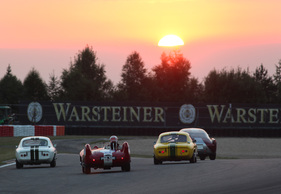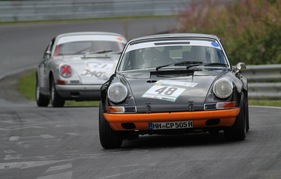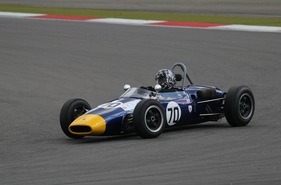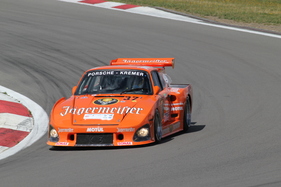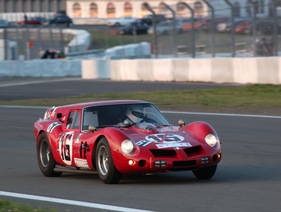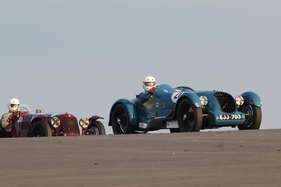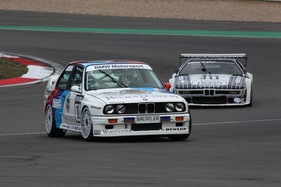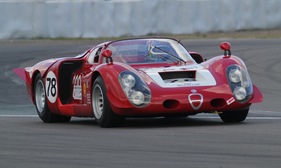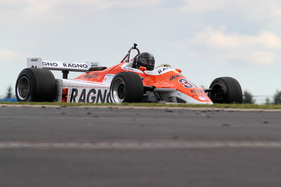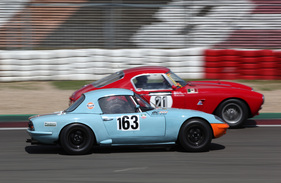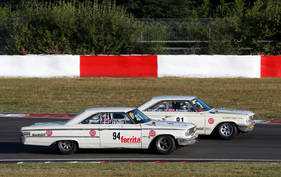For fans of historic racing, there is no shortage of opportunities to live out their passion. Nevertheless, around 50,000 spectators make the pilgrimage to the Nürburgring every year to watch the racing cars of yesteryear in their natural state, i.e. driving fast.
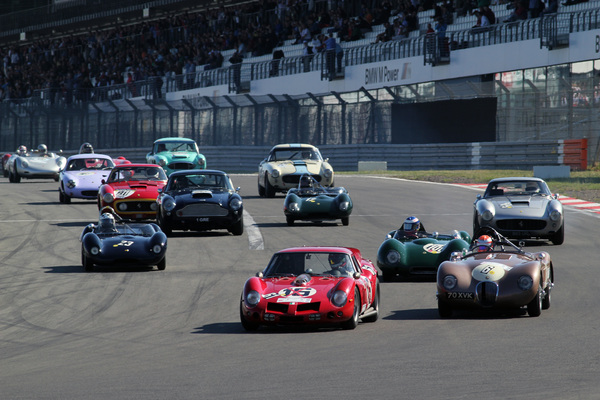
And in 2013, this was particularly worthwhile at the 41st edition, because not only did the program leave little to be desired, but the weather also held back for once and created ideal conditions with sunshine and moderate temperatures.
Uniformity wins
As always, the big Nürburgring weekend began for many of the spectators with the AVD Historic Marathon on the Nordschleife, run in combination with the Nürburgring Trophy. This is an endurance race lasting 210 minutes for touring cars and GTs built up to 1965, while the younger racing cars built between 1966 and 1971 complete 150 minutes as part of the Nürburgring Trophy.
The fans gathered around the more than 20 km long Nordschleife with its 73 bends and a difference in altitude of over 300 meters between the highest and lowest points. And they had plenty to see, both in terms of the field of vehicles and the driving skills of the participating drivers. From widely known racing cars such as the Porsche 911, the Alfa Romeo Giulia or the BMW 2002 to exotic cars such as the Marcos 1800 GT, the TVR Grantura or the Porsche 904, everything was there, with over 70 vehicles taking part in the race on Friday afternoon.
The AVD Historic Marathon was not won by one of the fast Jaguar E or the Porsche 904 GTS as expected, but by the slender Alfa Romeo Giulia Sprint GTA with a displacement of 1.6 liters. Alexander Furiani, who drove the car together with Olivier Ellerbrock, commented: "The victory was a real surprise for us. The decisive factor was certainly that we drove consistently. Anyone can conjure up a fast lap - but the marathon on the Nordschleife has to be approached consistently and with care for the material. Many people underestimate that."
Afschin Fatemi and Wolfgang Kaufmann in the Porsche 904 GTS looked like the sure winners for a long time, but in the end the engine was no longer running on all cylinders, so they had to settle for third place behind the Ford Mustang Mk1 of Reinhold Gröppner and Horst Walther.
The winner's trophy in the Nürburgring Trophy went to Nordschleife veterans Kersten Jodexnis and Wolfgang Destree in a Porsche 911 S/R. The next three places were also taken by other sports cars from Zuffenhausen, with Klaus Backes' spirited NSU TT finishing behind them.
Close races in the Formula Junior
Formula Junior is almost sworn to close battles for position and exciting races, and the two races in the Eifel were no exception. In practice, Michael Hibbert on his Lotus 27 was able to snatch pole position at the last minute, 0.157 seconds ahead of David Methley on a Brabham BT6, but Methley turned the tables in the first race and won by a wafer-thin margin of 0.75 seconds over his British colleague. Gelmini Tommaso finished third in a Branca FJ, followed by Christian Traber, who drove the ex-Siffert Lotus 22 to fourth place.
In the second race, which had to be started twice, Methley took the second winner's trophy, Hibbert was again second, Manfredo Rossi di Montalera was third this time in a Lotus 22. Christian Traber had to make do with fifth place, Audi works driver, Le Mans winner and Swiss by choice Marco Werner came ninth once and tenth once in the Cooper T59. For him, the return to his early driving days without paddle shifters and high-tech electronics was an exciting challenge. "This is 'back to the roots' racing," grinned the Dortmund-born driver, who also competed in the Historic Marathon in a Porsche 911.
His name was Bond
The two Bond racing cars were a special feature of the front-engine Formula Junior. Lawrence Bond, who was actually mainly involved with three- and four-wheeled small cars of the Bond and Berkeley brands, built the first monocoque formula car with the Bond Formula Junior in 1960, even before Colin Chapman did so with the Lotus 25.
The body of the Bond was constructed from aluminum panels and a plastic outer skin. Another special feature was that the single-seater was front-wheel drive. However, so much exoticism was not well received at the time that the racing cars did not sell. Success in racing also failed to materialize and the car lay dormant in Chris Featherstone's garage for almost 40 years.
With the increasing popularity of the historic Formula Junior, the Bond also became attractive again and it could be extensively restored. With the spare parts available, it was even possible to rebuild the second never-completed Formula Junior. And it was precisely these two cars that lined up at the start of the AVD Oldtimer Grand Prix and even achieved a class victory, as a belated honor for the ingenious concept, so to speak.
Marc Surer as double starter
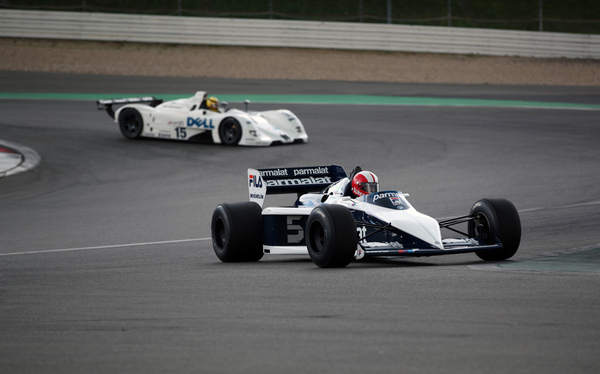
Marc Surer was a busy man at the Nürburgring. He had the honor of showing off the freshly restored Brabham BT52 with BMW four-cylinder turbo engine on demonstration laps and did so with great enthusiasm and impressive turbo flames at the exhaust. Marc Surer visibly enjoyed the drive: "It still has a real second to think before the turbo kicks in; it's actually more than a second, so you have to think while driving. But somewhere in my brain, this experience was probably still stored from before, at least I found it easy to get used to." Even the rev limit of 10,500 rpm didn't get in the way.
Behind Surer was Joachim Winkelhock in the 1999 Le Mans car, the BMW V12 LMR. He was delighted to perform an unintentional pirouette in the Yokohama-S.
In the two BMW one-make races for the BMW Group Classic Prize, Surer then got back behind the wheel and drove his BMW 320 E21 Group 5 from 1977. He dropped out of the first race, but in the second he drove almost to the front of the field and took his place among the M1 phalanx.
The first race was won by Christian Traber in a BMW M1, but Johnny Cecotti in an M3 E30 came within 1.8 seconds of him towards the end of the race. The horsepower of the Wagner M1 Turbo then won the second race.
Into the evening sun in a sports car/GT
When two-seater sports cars and Granturismo vehicles from the years up to 1960/1961 drive into the evening sun, this creates a very special atmosphere, not only visually but also acoustically. The race started at 20:15 and lasted until after nine o'clock, the sun had already set. And it was very fast.
For a long time, Alex Buncombe's Jaguar C-Type was in the lead, but towards the end he had to give way to Maximilian Werner - Gabriele Spangenberg had driven the first stint - in the brute-sounding Ferrari 250 GT SWB Breadvan.
The lightweight 1957 Lotus Eleven Le Mans with Philip Walker and Miles Griffiths at the wheel crossed the finish line in third place, followed by a Lola Mk1 from 1960, also small in displacement, driven by Jürg and Ronny Tobler.
The winning Ferrari 250 GT SWB "Breadvan" attracted a lot of attention at the weekend, as it is a one-off with a fascinating history. It was built by Giotto Bizzarrini on behalf of Count Volpi. The modification with the distinctive aerodynamic "combi-tail" shape made the 250 GT SWB even faster than the factory-built GTO, and Carlo Maria Abate and Colin Davis actually took the lead in this car at the 1962 24 Hours of Le Mans before retiring after six hours of racing. Victory at the AVD OGP gave the idiosyncratic sports car some satisfaction.
The following day, the same field then took to the stage in a Le Mans start that was highly publicized but meaningless in racing terms. In the second race, which was started conventionally after an intermediate stop, Alex Buncombe made up for his first-round deficit and took a commanding victory ahead of the Lotus Eleven of Walker/Griffiths. Jürg Tobler came third in the Lola, followed by an Aston Martin DB4 GT and the Ferrari 250 SWB Competition, which had been entered by Sportgarage Graber.
The Morgan SLR
A vehicle that very few people had seen before was the Morgan SLR, which competed in the "Gentlemen Drivers" for GT cars until 1965. The SLR goes back to John Sprinzel and Chris Lawrence , two men who were involved with Austin-Healey Sprite and Morgan sports and racing cars in the sixties.
With the Morgan SLR, the mechanical components of the Morgan Plus 4 were to be combined with a lightweight and aerodynamically advantageous aluminum body compared to the usual Morgan vehicles of the time. The result, presented at the 1964 Racing Car Show, did not look bad on the racetrack, even against the Porsche 904. Nevertheless, there were only four cars, one of which was based on a Triumph chassis.
In any case, the team placed in the front half of the field in practice and outpaced displacement giants such as the Corvette and the AC Cobra. In the race, it was enough for 16th place and the class win, not bad for a car that was put together in a backyard almost 50 years ago.
However, the Morgan was not the only exotic car in the field of GT vehicles; there was also a Cooper Bobtail from 1955, which finished the 50-minute race in 15th place.
The Gentlemen Drivers' race was won by Alex Buncombe in a Jaguar E Type, followed by Sean and Michael McInerney in a TVR Griffith. The AC Cobra Daytona, which had been in the lead for a long time, did not finish unscathed and was then taken out of the classification due to being underweight.
Jochen Mass had to settle for 11th place with his unclean-sounding Cobra. Swiss driver Michael Erlich was even worse off, having to leave the race on Saturday in his Bizzarrini 5300 GT without having achieved anything.
GT cars up to 1965 also competed in the AVD Touring Car Trophy, accompanied by the usual touring cars of the time such as the Ford Lotus Cortina or the Austin Mini Cooper S. It's a shame that there wasn't enough of a full-blown pre-1965 touring car field in this country. In the end, the GT cars stood at the top of the podium: a Lotus Elan 26R, a Ginetta G4 and another Lotus Elan.
Monoposti from different eras
Of course, the Formula 1 cars of the pre-turbo era were not to be missed in 2013 either. With their Cosworth sound and the already fully established sponsorship (cigarette brands were still allowed to advertise back then), they always provide a splash of color.
However, genuine overtaking maneuvers are almost as rare as in today's Formula 1, but the crowd was still delighted. The winner of both races was Michael Lyons in the Williams FW07 with the Penthouse/Old Smuggler livery, followed by Steve Hartley in the Arrows A4 and Joaquin Folch in the Brabham BT49C.
Grand Prix cars from the 1920s to 1950s competed in the older age groups. A large contingent of Maserati 250Fs made these races a special event. However, the fastest man on the Grand Prix circuit was Philip Walker in the Lotus 16B, although he only just managed to keep ahead of Julian Bronson's American Scarab Offenhauser .
Memories of the German Racing Championship
Various Porsche 911/935s, BMW M1s, Ford Capri, Opel Commodore, Chevrolet Stingray and a hot De Tomaso Pantera competed in the races of the 1972-1981 German Racing Championship revival. The Jägermeister-Porsche935 K3 under Wolfgang Kaufmann could not be denied victory in either race.
The DTM/STW and touring car revival provided further material for nostalgic dreaming. And just like in the good old days, a Bavarian BMW M3 (probably unintentionally) spun its Sindelfingen rival, the Mercedes Benz 190 E, around its vertical axis on one of the first laps. Yes, that's how it used to be.
Super-fast sports cars
In the two races for the FIA Masters Hisoric Sports Car Championship, the three-liter displacement (Ford Cosworth DFV) of the McLaren M8C from 1970 was unbeatable, but the two Alfa Romeo T33/2s and the portfolio of Porsche sports cars of types 906, 907 and 910 as well as the two exotic cars Chanabe Porsche and KMW Porsche SP 20 also provided a feast for the eyes.
Bugatti 35C on German tarmac for the first time since 1927
The pre-war fraction was also catered for, not with a cheerful exhibition race, but with a veritable race, in which an impressive array of fast sports cars such as a Maserati 6CM, MG K3, Delahaye 135 S or a fast Alta Sports, which promptly won the first race, could be seen.
Austrian Martin Halusa brought a very special vehicle to the start. His Bugatti 35C was the car originally entered by the factory in the 1927 San Sebastian Grand Prix. After being hidden away for years, it went to the USA in 1961, from where it has now returned to Europe.
The AvD Oldtimer Grand Prix was the first time it had been seen in Europe since the race in San Sebastian 85 years ago. "Everything on the 35c is actually original," explained Halusa. The engine, radiator, crankshaft housing and suspension have not been replaced since 1927. The handling of the material is correspondingly sensitive. "The engine gets warm, the springs become dangerously taut under load - you certainly can't win a race with it at the moment." It was still good enough for 16th place, his average speed was 92.618 km/h.
The second race was won by Josef Otto Rettenmaier in a Maserati 8C 3000.
Three days of a full program
A total of 18 races were held over the three-day Nürburgring weekend, but the audience was also offered a lot more. Opel presented an excerpt from its portfolio, Motor Klassik showed Le Mans vehicles in a tent, Coys organized an auction and there was more to see in the special parking lots of the brand clubs than could be viewed in one day.
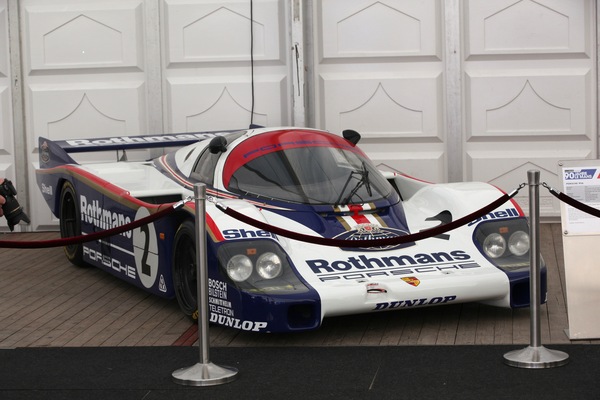
A particular highlight was certainly the Porsche 956 (chassis 956.007), which still holds the lap record of 6:11.13 on the Nordschleife with an average speed of over 200 km/h and which was presented once again in the green Holle with Derek Bell at the wheel as part of the "Stefan Bellow Tribute" and was also part of the Le Mans exhibition in the paddock.
With so many attractions, it will be interesting to see what the organizers come up with for next year when they host the AVD Oldtimer Grand Prix for the 42nd time.
The detailed results can all be viewed online on the AVD Oldtimer Grand Prix 2013 website .
Further pictures can be found in the referenced picture galleries. These galleries will be expanded over the coming days, so it's worth coming back several times.




































































































































































































































































